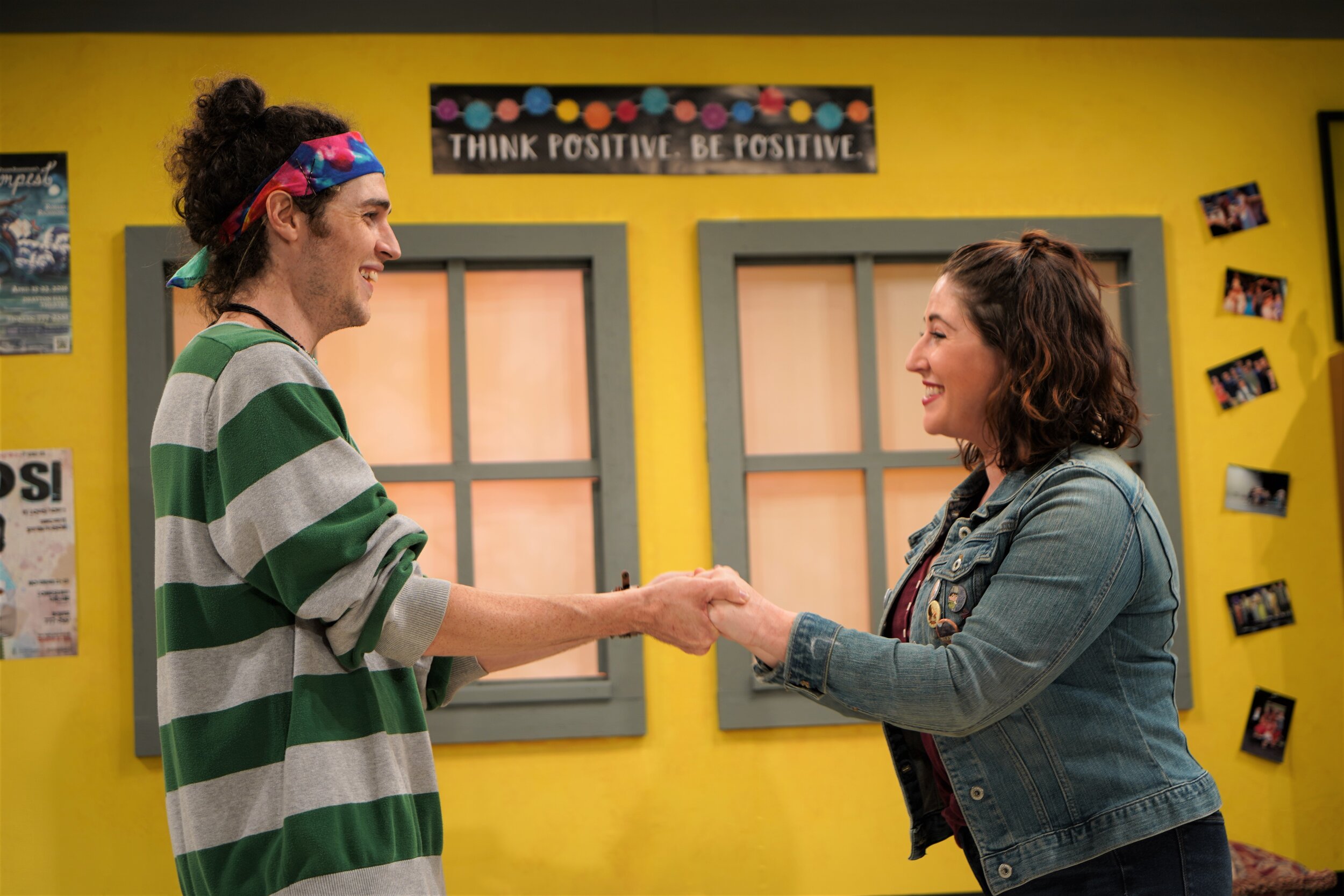“It’s a satire about white wokeness and the assumptions that we have always been taught about the Native American experience that we have accepted as fact, and how complex and impossible it is to create something that represents an oppressed group when that group isn’t even in the room. … Now, it’s one of the top ten most-produced plays in America and it fits in at Trustus perfectly. It’s modern, it’s challenging, it makes you laugh and then it makes you cringe that you just laughed…”
Abigail McNeely, director - The Thanksgiving Play
Abigail McNeely, director, The Thanksgiving Play at Trustus Theatre
As quarantine precautions continue to impact the opportunities for performing arts institutions to gather artists and audiences safely together, problem-solving and creative solutions are more highly valued than ever.
With a theatre that has been physically dark since March, Columbia’s beloved Trustus Theatre has offered a number of alternative events including a virtual play festival last month that brought us new plays with small casts live streamed three weekends in a row.
This week, the organization, under the watchful eye of Producing Artistic Director Chad Henderson, is raising the bar even higher with a brand new play being offered as a pay-for-view event—The Thanksgiving Play, a comedy by Larissa Fasthorse.
Jasper talked with Abigail McNeely who, in addition to directing The Thanksgiving Play, is also on staff at Trustus Theatre. We’re sharing this interview with you.
JASPER: First, tell us about your position at Trustus Theatre, how long you’ve been there, and what you do.
MCNEELY: I am the Administrative Assistant of Production and I started in May 2020. I do a lot of different things! I work closely with Chad, the Producing Artistic Director, and our technical staff, as well as our wonderful donors. When we return to live production, I’ll be working with production teams as well. A big part of my job over the last few months has been working on our Trustus LIVE series, which included filming, editing, and streaming video for our audiences at home. I was so excited to take on the challenge of taking the Trustus experience online and I’ve learned a lot. I’m really proud of the streaming work that we’ve done and it has all been leading up to The Thanksgiving Play, a production that combines both our practical live theatre skills and our virtual skills.
JASPER: And I know you graduated from USC – when was that and what was your major?
MCNEELY: I graduated from the University of South Carolina in 2017 with a Bachelor of Arts in Theatre. While there, I received the Helen Hayes Undergraduate scholarship and worked with Green Room Productions, the entirely student-run theatre production group, and was a member of TOAST Improv.
JASPER: Talk for just a minute about some of the plays you’ve been in or directed and maybe choose one or two favorites.
MCNEELY: There are so many! I’ve been doing theatre since high school and each project feels like it teaches me something new. Some highlights:
· Bloody Bloody Andrew Jackson, which marked my fifth musical here at Trustus (and unfortunately closed in after just two performances due to COVID – but we’ll be back!). I love working with Chad on musicals. It’s like you stepped into a music video. It’s a blast.
· A Bright New Boise by Samuel D. Hunter which I directed my senior year of college with some of my very close friends through Green Room. Hunter is one of my favorite playwrights. Funny and dark and full of heart.
· A Christmas Miracle at the Richland Fashion Mall, written by The Mothers, Trustus’ resident comedy group that I am proudly a member of. I was honored to get to direct our very first full-length play that was a love letter to some of our favorite Columbia things.
Patrick Dodds and Kayla Cahill Machado
JASPER: Now, let’s hear about the Thanksgiving Play – who wrote it and what should viewers expect from the content of the play?
MCNEELY: The Thanksgiving Play is written by Larissa FastHorse (Sicangu Lakota Nation). The show is about four people coming together to try and create a politically correct, culturally-sensitive play about Thanksgiving during Native American Heritage Month. Those four people all happen to be white, not a single Indigenous voice in the room. It’s a satire about white wokeness and the assumptions that we have always been taught about the Native American experience that we have accepted as fact, and how complex and impossible it is to create something that represents an oppressed group when that group isn’t even in the room. FastHorse wrote this play to explore these issues with only white people in the cast in response to being told that her other plays couldn’t be produced for lack of Indigenous actors. Now, it’s one of the top ten most-produced plays in America and it fits in at Trustus perfectly. It’s modern, it’s challenging, it makes you laugh and then it makes you cringe that you just laughed… it’s what I think of when I think about “a Trustus show.”
JASPER: Who will we get to see performing?
MCNEELY: Four really wonderful actors from the Trustus company – Kayla Cahill Machado (Bloody Bloody Andrew Jackson), Brittany Hammock (A Streetcar Named Desire and the Jasper Theatre Artist of the Year recipient for 2019), Patrick Dodds (Sweat), and Clint Poston (Marjorie Prime). We knew we wanted to stay within the Trustus family for this show and these four actors were my first choice. I’ve had the pleasure of watching and working with each of them multiple times and I appreciate their dedication and their willingness to try new things. Getting them all in to the same cast was a dream.
JASPER: And now, the obvious, how exactly will we get to see this play?
MCNEELY: The Thanksgiving Play is Trustus’ very first virtual on-demand show. After a month of quarantine and testing, we brought our cast and crew in to film the show to then stream online. It’s similar to renting a movie off of Amazon – you pay for an access code that is good any time between November 11-21, and once you begin watching it, you have 48 hours to finish it. Tickets can be purchased online at trustus.org and any questions can go to our Box Office Manager, Brandon Martin (boxoffice@trustus.org). He was instrumental in creating our online experience and ensuring it still felt like Trustus even from the comfort of your couch.
It’s similar to renting a movie off of Amazon – you pay for an access code that is good any time between November 11-21, and once you begin watching it, you have 48 hours to finish it. Tickets can be purchased online at trustus.org
JASPER: As the director, tell us about some of the challenges you encountered in putting this play together and how you problem-solved them.
MCNEELY: We started the process completely online, rehearsing over Zoom. The first few days of a rehearsal process are vital in building ensemble and getting the show up on its feet to block, so having to do so online was challenging, but thankfully, the cast took to it easily.
After two weeks of virtual rehearsal, we started in-person rehearsals. It was a breath of fresh air to have people back in the theatre again. We were masked when not on stage, lots of hand sanitizer, weekly testing… Above all, we had to do this safely. It means nothing to bring theatre back if it’s done haphazardly. While we were in the space, we ran the show and added costumes and props just like any normal rehearsal process. It felt good to be back in the rhythm of things. After another two weeks, we filmed the entire show over Halloween weekend. It was a whirlwind process. The staff worked so hard to make it happen. It was exciting to get to work with my team on a production together.
Brittany Hammock
JASPER: Assuming we haven’t seen the play yet, key us in to one of your favorite or funniest parts to look forward to.
MCNEELY: One of the most fun things about the show is that it’s a play with music, so in between each of the scenes with the group creating the play, we get a glimpse at some of the outdated Thanksgiving songs and pageants that have been performed over and over again. FastHorse wrote these based on real songs she came across while writing the play, and they are perfectly campy in their performance and cringey in their content. There’s also a scene involving a head. That’s all I have to say about that.
JASPER: Is there anyone whose praises you’d like to take this opportunity to sing?
So many people! The time we spent rehearsing online gave us ample time to discuss characters and intentions and engage in conversations about some of the tougher topics. We had discussions with Eva Foussat, an Indigenous member for the Trustus board, and Terrance Henderson, Trustus company member and the chair of our Equity Task Force. I’m so thankful for their time. It was essential to have POC voices at the table when we discussed this play. Otherwise, we would’ve been doing exactly what the play tells us not to do: talk the talk but don’t walk the walk. Perform radical wokeness without working with or listening to BIPOC.
I’d also love to shout out the musicians we worked with on the show. We asked Greg Apple to create the transition music you’ll hear between scenes, and what he and Chad came up with is so fun: tribal beats that morph into jazzy tunes. It reminds me a lot of Vince Guaraldi’s score for the Peanuts specials, perfect for the holidays. Then, we reached out to two of my favorite musicians to fill in the music for the rest of the show. Chris Cockrell, Trustus company Emeritus member, scored scenes 1, 3, and 7 and Daniel Machado, whose wife Kayla plays Logan in the show, scored scene 5 and the credits. Daniel also stepped up to the plate as a camera operator and sound mixer for the entire show. He’s helped so much.
I’ve never felt this way about collaboration before. I am so lucky to have worked with so many different artists in such a short, loud time and created something we can all be proud of.
JASPER: And what’s next for you and Trustus?
Coming up on November 21st, we’re hosting three awesome bands in the alleyway outside of the theatre for Rock the Block – a fun(d)raiser for Trustus Theatre! Brandy and the Butcher, Les Merry Chevaliers, and E.Z. Shakes are playing, Scott Hall’s got the food, and we’ll be pouring drinks. It’s going to be so much fun. Info can be found online at https://trustus.org/event/rock-the-block/. After that, we’ll be installing new air filtration systems to hopefully return to live performance soon. Stay tuned!






































